Oops! Sorry – I didn’t know that when I thought I “invented” it!!!
I call this stitch the “ksc stitch” (knit single crochet stitch). AKA vsc because we work the sc into the “v” of the stitch below. I came upon it in experimentations. I call it “Knit single crochet” (or ksc for short) because it looks like a stockinnette knit stitch, doesn’t it?
For me, this is the ideal stitch for use in crochet amigurumi doorstops and for tapestry crochet bags. The ksc stitch produces a very strong fabric (almost like woven canvas) and is so dense that it is prevents weighted amigurumi small stuffing from falling out.
For a long while, I thought that there was just one single crochet (sc). Then recently I paid more attention to a stitch called “Modified single crochet”. But shortly after that, I found that there was no one definitive type of ‘modified sc’. In fact, there are various ‘modified single crochet’ stitches so that the name by and of itself is not very helpful nor definitive.
Common Crochet Stitch used in Amigurumi dolls
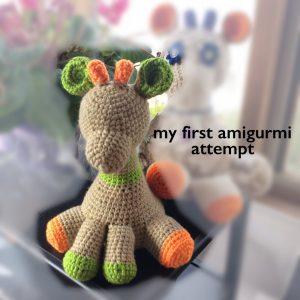 On asking Google and Pinterest and even from amigurumi patterns, I can see that the most commonly used crochet stitch is the standard sc (single crochet). However I found that no matter how tightly I crocheted, the resultant holes (spaces between stitches) were too large for my liking.
On asking Google and Pinterest and even from amigurumi patterns, I can see that the most commonly used crochet stitch is the standard sc (single crochet). However I found that no matter how tightly I crocheted, the resultant holes (spaces between stitches) were too large for my liking.
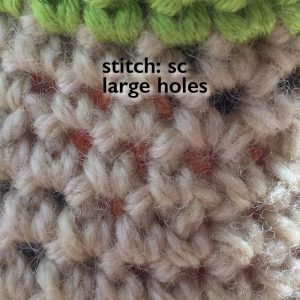 In this first amigurumi project, I was making an amigurumi doorstop. I was using glass beads for the required weight. The beads kept seeping out, bit by bit, through the holes. So this first creation was later hacked and cut up to rescue the precious heavy beads! (Good stuffing materials are expensive!)
In this first amigurumi project, I was making an amigurumi doorstop. I was using glass beads for the required weight. The beads kept seeping out, bit by bit, through the holes. So this first creation was later hacked and cut up to rescue the precious heavy beads! (Good stuffing materials are expensive!)
Here is a close up of the crocheted fabric using single crochet stitch (sc). See how large the holes are. (You can even see the orange stuffing of recycled materials within.)
Not only can small pellets/beads fall out, but it is a bit unsightly (to me) to be able to see the stuffing especially as most stuffing is white in colour. That really shows up if you are using dark yarn for your amigurumi crochet.
So I went searching for a better stitch. One that would produce a strong and dense fabric.
Common Crochet Stitch used in Tapestry Crochet and Wayuu Bags
 In the meantime, I was also trying out tapestry crochet. The Wayuu bags are a good example of tapestry crochet. They looked very enticing to me so I decided to do some research.
In the meantime, I was also trying out tapestry crochet. The Wayuu bags are a good example of tapestry crochet. They looked very enticing to me so I decided to do some research.
Some crocheters use the standard sc stitch in tapestry crochet and in their wayuu bags. However I find that that produces a fabric that is too ‘holey’ and not quite strong enough to ensure durability in the face of possible rough, daily usage.
If I was going to make these kinds of bags, I wanted a resultant fabric that felt and was in fact, very strong to ensure that the bags would be sturdy and long-lasting.
There are lots of videos on Wayuu bags and on tapestry crochet on youtube. Most crocheters seem to use a stitch which they call “modified single crochet” in the making of Wayuu type bags. As I said above, if you look around, there is more than one version of “modified single crochet” around. The video below is an example of the most popular type of ‘modified sc’ used in wayuu bags.
This video, by All Tapestry Crochet, is particularly clear and instructive. As she says, she is using “modified single crochet”.
This version of “modified sc” seems to be the most commonly used sc stitch for tapestry bags and for Wayuu bags in particular. It’s main advantage is that it produces stitches that are stacked on top of each other (ideal of creating “pictures” in your crochet with minimal distortion or slanting stitches).
It also produces a horizontal ridge in your crocheted fabric. This can be very useful and decorative when used effectively.
I tried out this modified sc and while I like it, it does not produce as strong a fabric as does my ksc stitch (knit single crochet stitch).
The Knit Single Crochet Stitch
Once again, I apologize for not being able to make a how-to video for you. I just don’t know how even though I have tried and tried. I only produce shockers.
The advantages of KSC stitch:
- very very strong and dense fabric (perfect for bags and amigurumi stuffed creations)
- stitches stack up vertically (which is important when crocheting ‘images’)
The ksc stitch is a very easy variation of the single crochet stitch.
Instead of putting the hook through the top 2 loops, insert the hook into the “v” of the previous row. Then do as you would a normal sc: yarn over, pull through, yarn over and pull through the 2 loops on hook.
Tip: if you are doing tapestry crochet and are using multiple colours, you don’t need to float the unused yarn behind. In fact, you don’t want to do that. Rather, catch the strands of unused yarn as you work.
Here are some close up photos of my KSC stitch.
You can see from this photo, comparing sc stitch vs ksc stitch, that I originally started calling the ksc as shallow single crochet. That was because this stitch is worked lower into the previous row which ultimately produces a shorter fabric for the same number of rows.
However I finally decided to call the stitch knit single crochet as it is more descriptive and hence will be easier to call the stitch to mind.
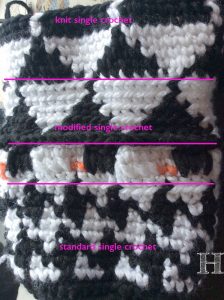 In this next photo, you can see 3 variations of the sc (knit single crochet, modified sc, standard sc).
In this next photo, you can see 3 variations of the sc (knit single crochet, modified sc, standard sc).
As mentioned above, you can see that the modified single crochet produces that distinctive horizontal ridges.
And you can see that the standard sc is relatively less tidy looking than the other two sc variations.
Here are a couple of WIP (work in progress) photos. They illustrate the use of knit single crochet stitch. The ksc stitch is currently my favourite crochet stitch for amigurumi projects for its tough sturdiness, its ideal suitability for creating un-skewed images, and for its densely packed stitches.
Hope this was helpful to you dear reader. Feel free to comment and/or sign up for my free newsletter. Don’t worry. You will not be inundated by my newsletters. I am quite a lazy blogger and so you will only hear from me periodically or when I undergo a blogging phase! 😀 Namaste!
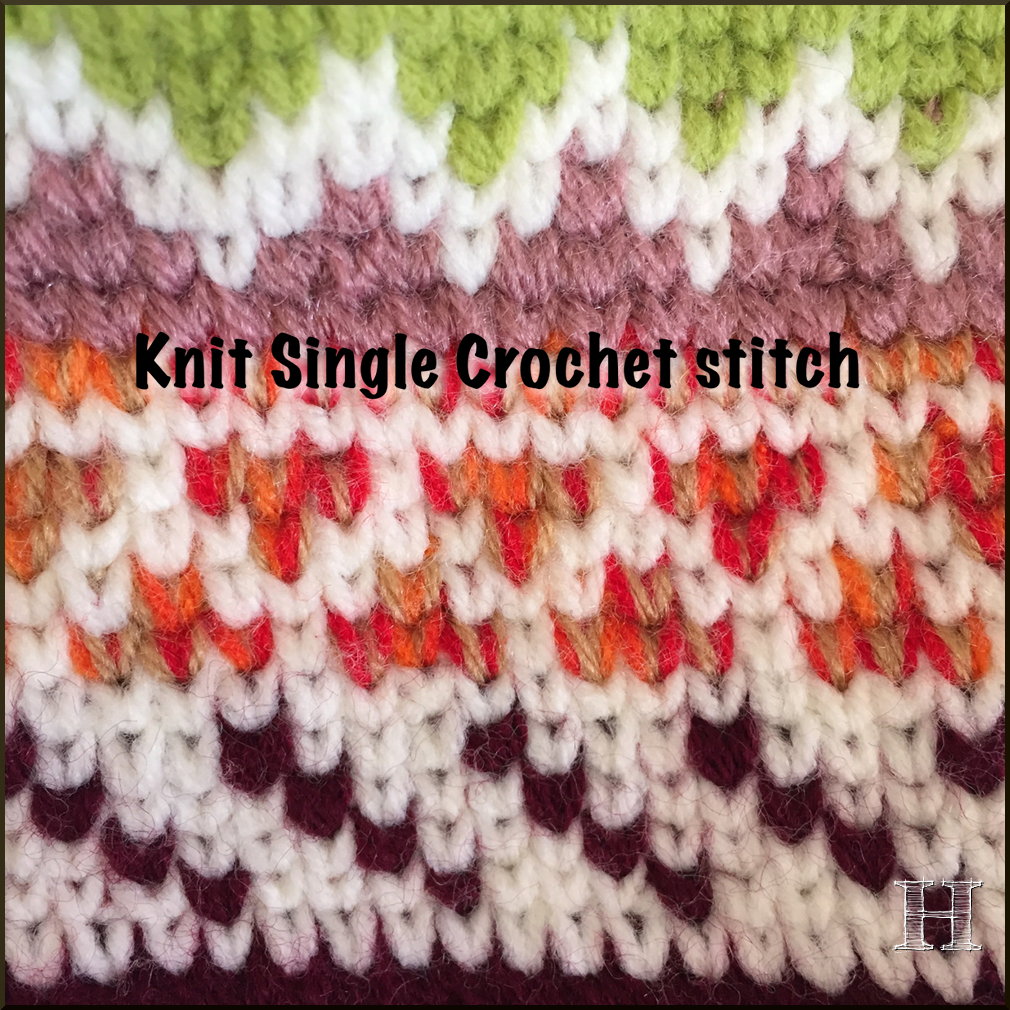
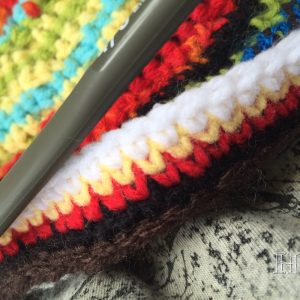
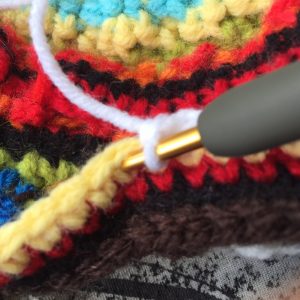
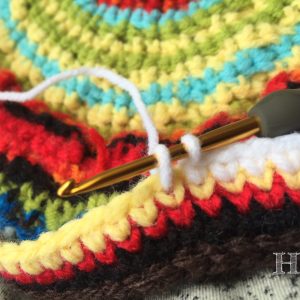
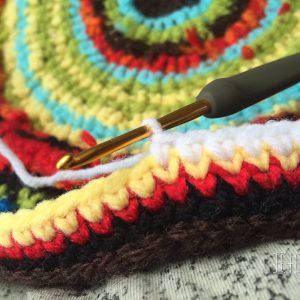
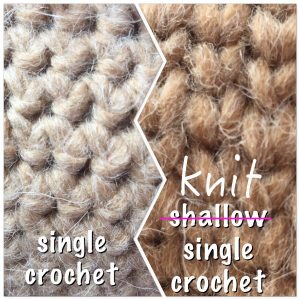
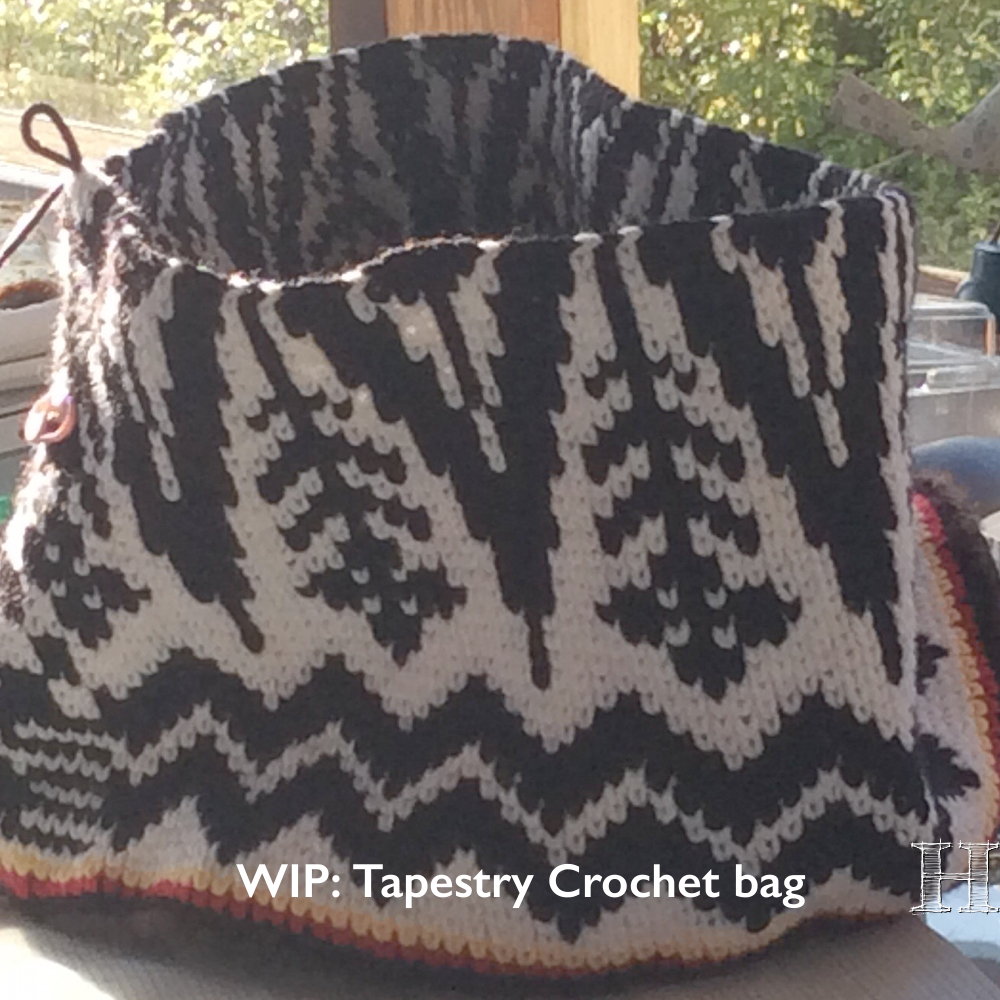
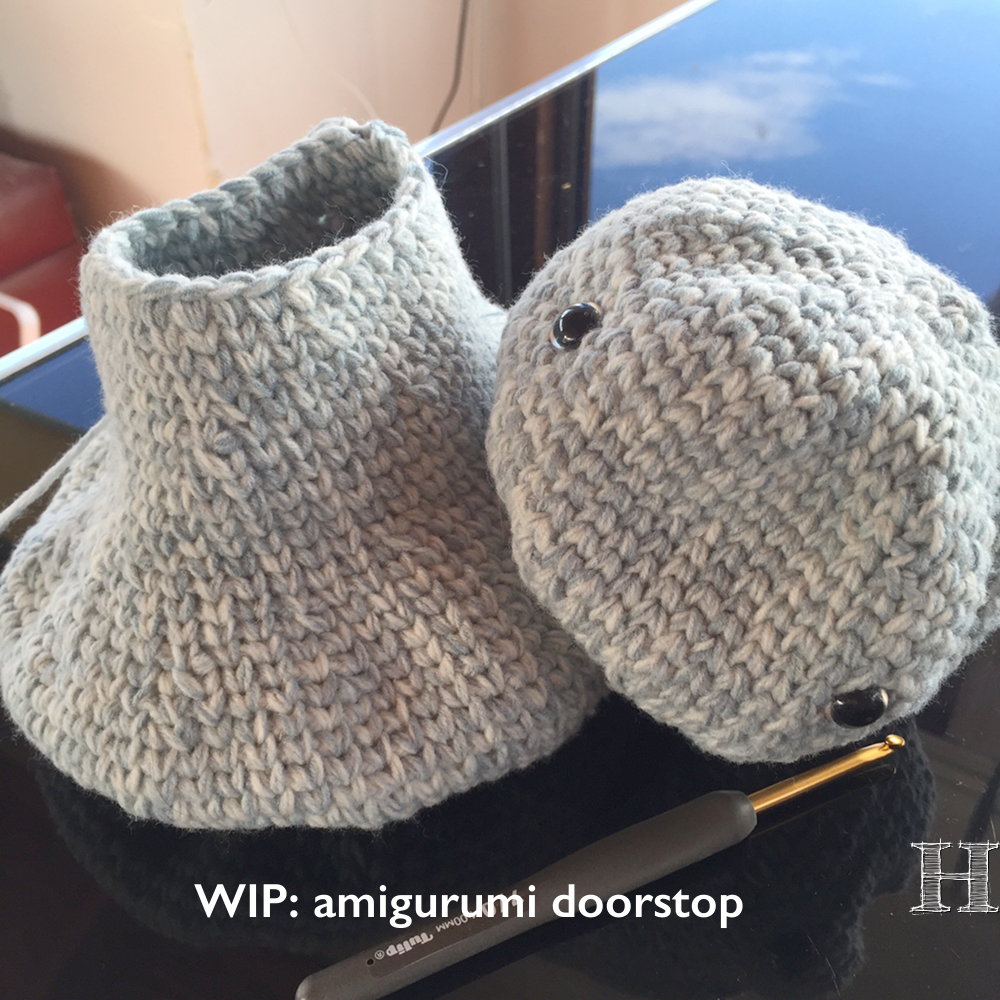

I wondered why it’s always BL only in tapestry. This is not a ‘modified stitch’ it is Back Loop single (or double here in the UK),
Very nice tutorial! This stitch was traditionally called waistcoat stitch
Thank you Mel! You are so right! This knit-single crochet stitch indeed is called the waistcoat stitch. I have now added this note into the article. Thanks again!
Genius! I immediately thought of crochet socks?!
Hi Carly, thanks! Good idea! Just remember that this crochet stitch produces a firmer, thicker fabric than the knitted stockinette stitch. So you may have a little bit of playing around and adjustment. But it sounds like a great idea. Do share your results please.
I have made a wayuu bag using the knit stitch and a very simple pattern on the circular base. I would like to create a more complex pattern on the base, but don’t know when/where to place the increases when using a knit stitch. Can you help?